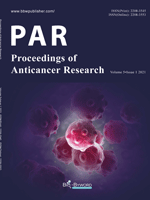Abstract
Vasculogenic mimicry (VM) in lung cancer shortens overall survival (OS) but its’ associations with postoperative recurrence and progression of early non-small cell lung cancer (NSCLC) remain unclear. The purpose of this study was to analyze the association of VM with postoperative recurrence and progression of NSCLC as well as the effect of VM on postoperative recurrence-free survival (RFS). This study included NSCLC patients and detected VM in surgical specimens. The associations of VM with the recurrence and progression were analyzed to assess the effect of VM on postoperative RFS in NSCLC. A total of 80 NSCLC cases were followed up for 3 years. During follow-up, 35 cases showed recurrence and progression where 5 (6.25%) cases had simple local recurrence and the other 30 (37.5%) cases had distant metastasis. The recurrence and progression rates in the first, second, and third years were 12.50%, 23.75%, and 7.50%, respectively. The median RFS was 14.2 months. VM was detected in 30 out of 80 cases and was significantly correlated with tumor differentiation (r = 0.365) and clinical stage (r = 0.374) (both, P = 0.001). Local recurrence of NSCLC was not correlated with VM, unlike distant metastasis (r = 0.598, P < 0.001). Average RFS was significantly longer in NSCLC patients without VM compared with the VM group 3 years post-operation (32 months versus 18 months, log-rank test P < 0.001). Considering these, VM is significantly correlated with postoperative distant metastasis of NSCLC in which it is of a certain value for predicting poor prognosis in NSCLC.
References
Barnett R, 2017, Lung Cancer. Lancet, 390(10098): 928.
Dziedzic DA, Rudzinski P, Langfort R, et al., 2016, Risk Factors for Local and Distant Recurrence after Surgical Treatment in Patients with Non-Small-Cell Lung Cancer. Clinical Lung Cancer, 17(5): e157-67.
Ge H, Luo H, 2018, Overview of Advances in Vasculogenic Mimicry - A Potential Target for Tumor Therapy. Cancer Management and Research, 10: 2429-37.
Ren HY, Shen JX, Mao XM, et al., 2019, Correlation between Tumor Vasculogenic Mimicry and Poor Prognosis of Human Digestive Cancer Patients: A Systematic Review and Meta-Analysis. POR, 25(3): 849-58.
Ettinger DS, Wood DE, Akerley W, et al., 2014, Non-Small Cell Lung Cancer, version 1. JNCCN, 12(12): 1738-61.
Sun H, Zhang D, Yao Z, et al., 2017, Anti-Angiogenic Treatment Promotes Triple-Negative Breast Cancer Invasion Via Vasculogenic Mimicry. Cancer biology & therapy, 18(4): 205-13.
Xi JJ, Yin JC, Wang L, et al., 2018, A Surveillance Method-Oriented Detection of Post-Operative Spatial-Temporal Recurrence for Non-Small Cell Lung Cancer. Journal of Thoracic Disease, 10(11): 6107-17.
Lv C, An C, Feng Q, et al., 2015, A Retrospective Study of Stage I to IIIA Lung Adenocarcinoma After Resection: What is the Optimal Adjuvant Modality for Patients with an EGFR Mutation? Clinical Lung Cancer, 16(6): e173-81.
Zhang Z, Liu D, Guo Y, et al., 2010, Effects of Multiple Factors on the Prognosis of pIIIa/N2 Patients with Non-Small Cell Lung Cancer. Chinese Journal of Lung Cancer, 13(8): 781-5.
Komatsu H, Izumi N, Tsukioka T, et al., 2019, Prognosis Associated with Synchronous or Metachronous Multiple Primary Malignancies in Patients with Completely Resected Non-Small Cell Lung Cancer. Surgery Today, 49(4): 343-9.
Yang H, Li X, Shi J, et al., 2018, A Nomogram to Predict Prognosis in Patients Undergoing Sublobar Resection for Stage IA Non-Small-Cell Lung Cancer. Cancer Management and Research, 10: 6611-26.
Ucvet A, Yazgan S, Gursoy S, et al., 2018, Prognosis of Resected Non-small Cell Lung Cancer with Ipsilateral Pulmonary Metastasis. The Thoracic and Cardiovascular Surgeon.
Shen R, Wu T, Huang P, et al., 2019, The Clinicopathological Significance of Ubiquitin-Conjugating Enzyme E2C, Leucine-Rich Repeated-Containing G Protein-Coupled Receptor, WW Domain-Containing Oxidoreductase, and Vasculogenic Mimicry in Invasive Breast Carcinoma. Medicine, 98(16): e15232.
Wang Y, Yang R, Wang X, et al., 2018, Evaluation of the Correlation of Vasculogenic Mimicry, Notch4, DLL4, and KAI1/CD82 in the Prediction of Metastasis and Prognosis in Non-Small Cell Lung Cancer. Medicine, 97(52): e13817.
Liu Y, Mei L, Yu Q, et al., 2015, Multifunctional Tandem Peptide Modified Paclitaxel-Loaded Liposomes for the Treatment of Vasculogenic Mimicry and Cancer Stem Cells in Malignant Glioma. ACS Applied Materials & Interfaces, 7(30): 16792-801.
Quiros-Gonzalez I, Tomaszewski MR, Aitken SJ, et al., 2018, Optoacoustics Delineates Murine Breast Cancer Models Displaying Angiogenesis and Vascular Mimicry. British Journal of Cancer, 118(8): 1098-106.
Wagenblast E, Soto M, Gutierrez-Angel S, et al., 2015, A Model of Breast Cancer Heterogeneity Reveals Vascular Mimicry as a Driver of Metastasis. Nature, 520(7547): 358-62.
Williamson SC, Metcalf RL, Trapani F, et al., 2016, Vasculogenic Mimicry in Small Cell Lung Cancer. Nature Communications, 7: 13322.
Bradbury P, Sivajohanathan D, Chan A, et al., 2017, Postoperative Adjuvant Systemic Therapy in Completely Resected Non-Small-Cell Lung Cancer: A Systematic Review. Clinical Lung Cancer, 18(3): 259-73, 258.
